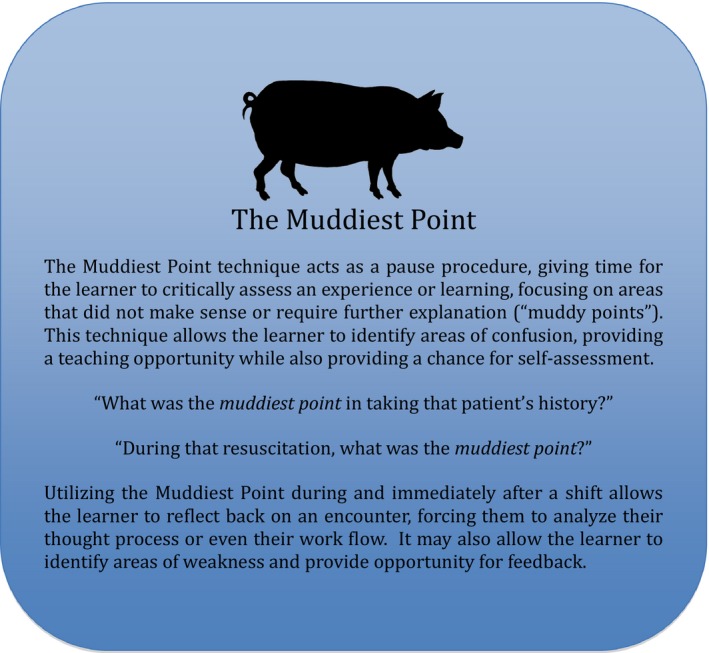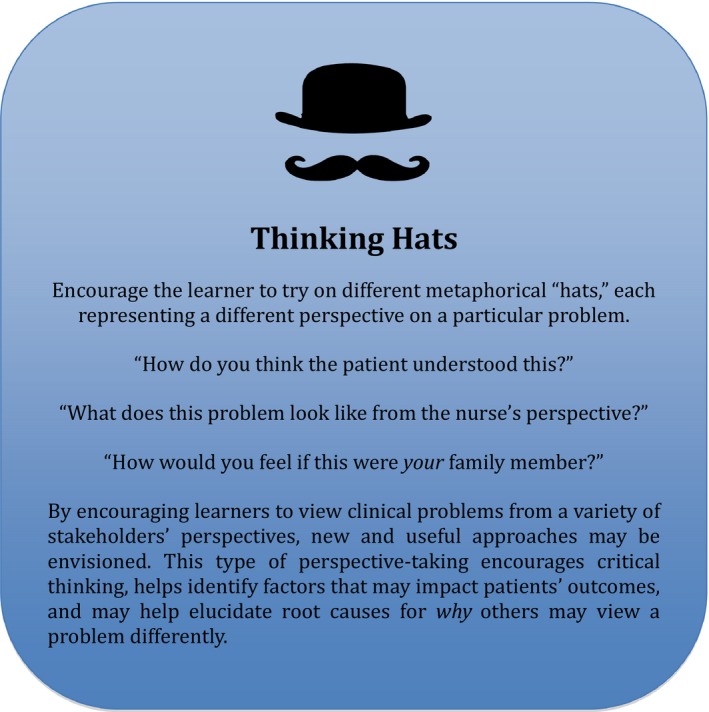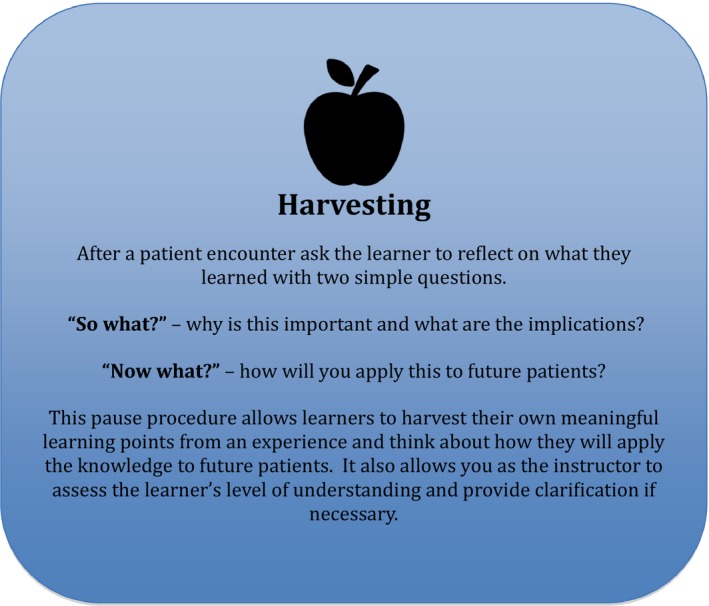Although teaching and learning in emergency medicine (EM) take innumerable forms, bedside teaching in the clinical environment is essential in EM education. Trainees develop expertise over time by working side by side with experienced mentors to gain insight and build understanding. However, bedside teaching in the emergency department is fraught with challenges: high‐volume patient numbers, frequent interruptions, and competing demands, as well as changing makeup of teacher/learner teams.1 In addition, information cannot simply be delivered passively if it is expected to be fully integrated into the learner's understanding.2, 3 A bedside lecture, even framed in the clinical context, remains a passive teaching modality. Clinical teachers in EM must incorporate efficient teaching into the clinical encounter, while assessing learners’ clinical reasoning and providing for safe and expedient patient care.
Multiple frameworks, such as the One‐Minute Preceptor and SNAPPS, have been developed for teaching and assessing clinical reasoning skills in time‐sensitive environments, while a number of other discrete teaching tools have been proposed to augment these teaching schemas.1, 4 Here, we describe three simple but powerful techniques that may be used in the EM workplace to create active learning moments. Used alone or within a broader framework, these techniques do not require preparation or significant time and may be adapted for a variety of clinical contexts to encourage contextualization of knowledge content, clarify difficult concepts, and improve bedside teaching. Based on a constructivist perspective on learning, these techniques prompt learners to actively create connections between past knowledge and current experience, with an eye toward future applications.5, 6 The teacher is a facilitator of this construction rather than a purveyor of facts.
Consider the following case example, presented by a trainee:
“Julie is a 16‐year‐old girl who presents with right lower quadrant abdominal pain. It started several days ago but got worse after gymnastics practice yesterday. It is currently 10/10, worse with movement. She has vomited twice but has not had fevers, diarrhea, or constipation. She denies any medical issues or surgeries. Her last period was 2 weeks ago. She is here with her parents and it was embarrassing to ask about a sexual history, so I didn't press the issue but she does not smoke or use drugs. She looks uncomfortable on exam but her only significant finding is exquisite tenderness in the right lower quadrant. I'm worried about appendicitis and think we should get a CT scan and consult surgery.”
As the clinical educator, consider the following techniques when staffing this patient with your trainee:

As a supervisor, you ask your trainee, “When talking with Julie, what seemed to be the muddiest point in your history?”
Your trainee responds, “Well, I knew I needed to consider STI's in my differential but it was difficult to obtain a social history from Julie with her family in the room. It was awkward to have that discussion … I suppose I could have asked them to step out momentarily to ask more questions.”
By allowing your trainee to identify the most difficult portion of a scenario, you allow him or her to trouble shoot their process in a guided manner. This promotes self‐guided reflection and future improvements.
You ask your trainee to consider the scenario from Julie's perspective:
“If you were a teenage girl, would you want to talk about sexual history with family in the room? Would you be worried about confidentiality? Safety? Would you be honest?”
By considering various perspectives, including that of the learner (“Why did you not ask about sexual history? Does it make you uncomfortable? Were there other reasons?”), learners can reflect on their practices and identify opportunities for improvement in future interactions.


A pelvic exam is performed and is concerning for cervical motion tenderness with discharge. An ultrasound is ordered and is normal. Julie is diagnosed with pelvic inflammatory disease based on these findings.
You ask the learner “So, what did you learn from this case?”
Your trainee responds, “Pelvic inflammatory disease can present surprisingly like appendicitis!”
You follow‐up by asking, “Now what will you do next time?”
Your trainee replies, “I will take a confidential sexual history on every adolescent patient!”
By asking the trainee to pause, reflect on what he or she has learned, and commit to a future action, he or she is more likely to learn from the experience.
While not every teaching technique is suitable for every learning scenario, by becoming facile with a number of discrete, specific options, clinical educators can develop a versatile bedside teaching toolbox
Dr. Merritt receives support from an Academic Development Award from the Department of Emergency Medicine, Alpert Medical School of Brown University. Dr. Santen receives support from the Accelerating Change in Medical Education Grant from the American Medical Association.
The authors have no potential conflicts to disclose.
References
- 1. Aldeen AZ, Gisondi MA. Bedside teaching in the emergency department. Acad Emerg Med 2006;13:860–6. [DOI] [PubMed] [Google Scholar]
- 2. Freeman S, Eddy SL, McDonough M, et al. Active learning increases student perfzormance in science, engineering, and mathematics. Proc Natl Acad Sci U S A 2014;111:8410–5. [DOI] [PMC free article] [PubMed] [Google Scholar]
- 3. Melo Prado H, Hannois Falbo G, Rodrigues Falbo A, Natal Figueirôa J. Active learning on the ward: outcomes from a comparative trial with traditional methods. Med Educ 2011;45:273–9. [DOI] [PubMed] [Google Scholar]
- 4. Green GM, Chen EH. Top 10 ideas to improve your bedside teaching in a busy emergency department. Emerg Med J 2015;32:76–7. [DOI] [PubMed] [Google Scholar]
- 5. Wolff M, Wagner MJ, Poznanski S, Schiller J, Santen S. Not another boring lecture: engaging learners with active learning techniques. J Emerg Med 2015;48:85–93. [DOI] [PubMed] [Google Scholar]
- 6. Yardley S, Teunissen PW, Dornan T. Experiential learning: AMEE Guide No. 63. Med Teach 2012;34:e102–15. [DOI] [PubMed] [Google Scholar]


